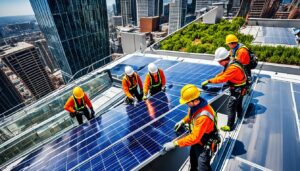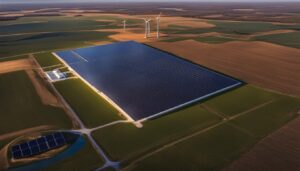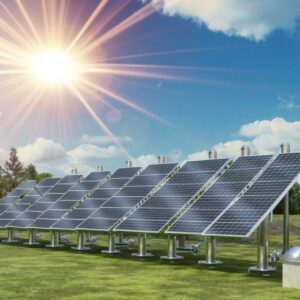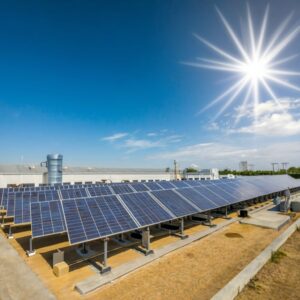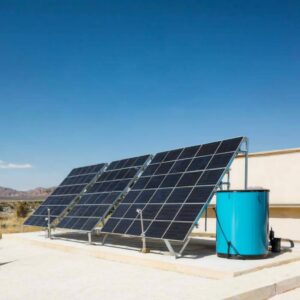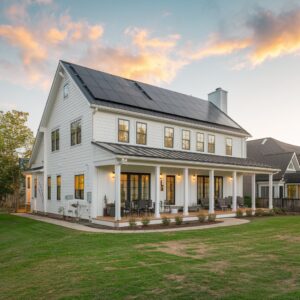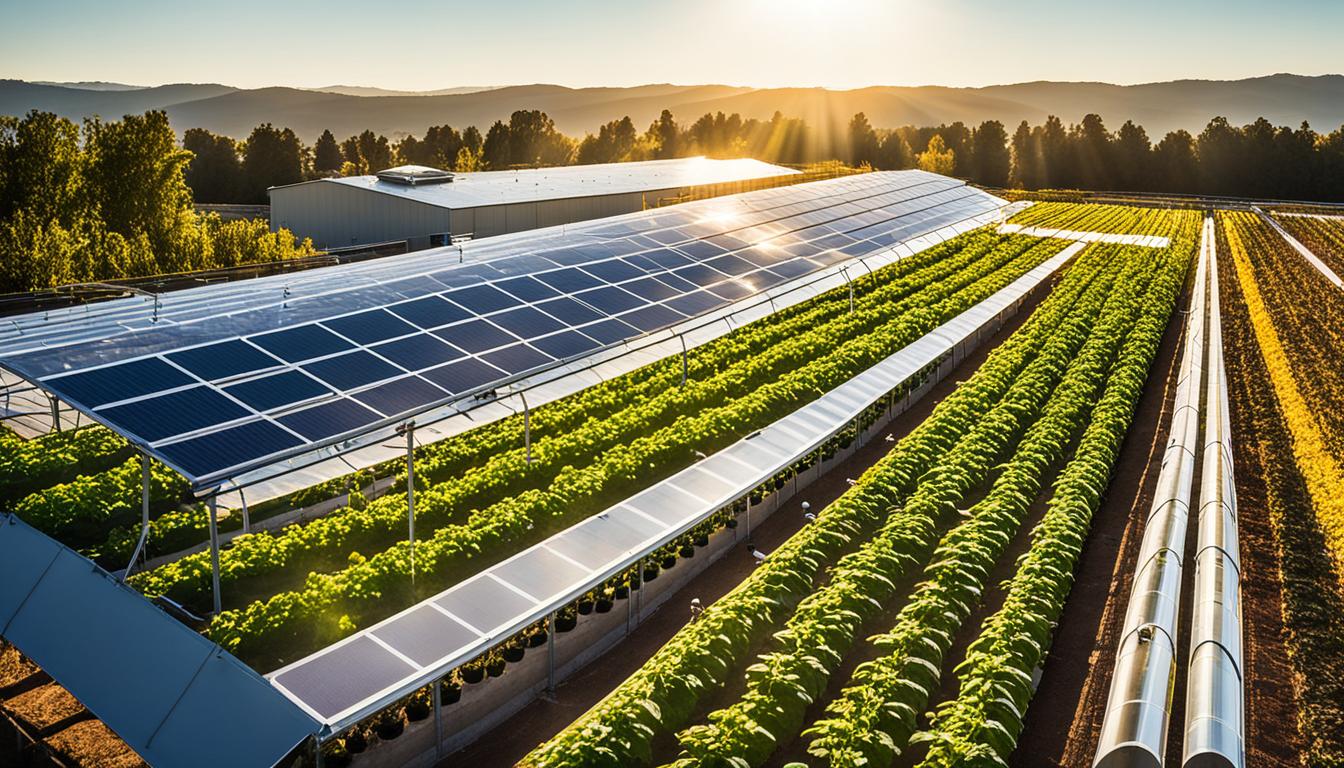
Greenhouse growers are increasingly turning to advanced solar energy techniques to optimize plant health and maximize yields. By harnessing the power of solar energy, greenhouse owners can create a more sustainable and eco-friendly growing environment while reaping the benefits of increased productivity and cost savings.
In this article, we will explore the various ways in which solar energy can be utilized in a greenhouse setting, from providing supplemental lighting to powering ventilation systems and irrigation pumps. We will also delve into the advantages of using solar energy in greenhouse operations and highlight real-world examples of successful solar-powered greenhouses.
Key Takeaways:
- Solar energy can significantly enhance greenhouse growth and yield by providing a sustainable and cost-effective power source.
- Solar-powered lighting systems in greenhouses ensure optimal photosynthesis and reduce reliance on traditional grid electricity.
- Using solar energy for heating and ventilation helps maintain ideal temperatures and control humidity levels in the greenhouse.
- Advantages of solar energy in greenhouse operations include sustainability, cost savings, and reduced environmental impact.
- Solar-powered greenhouses contribute to a greener approach to agriculture and promote a more sustainable future.
Harnessing Solar Energy for Lighting in Greenhouses
One of the key applications of solar energy in greenhouses is for lighting purposes. Since natural sunlight can be limited, especially during the winter months or in regions with cloudy weather, supplemental lighting becomes crucial for plant growth.
Solar-powered LED lights can be installed in greenhouses to provide the necessary light spectrum for photosynthesis. These lights can be strategically positioned to ensure uniform coverage and optimal plant growth.
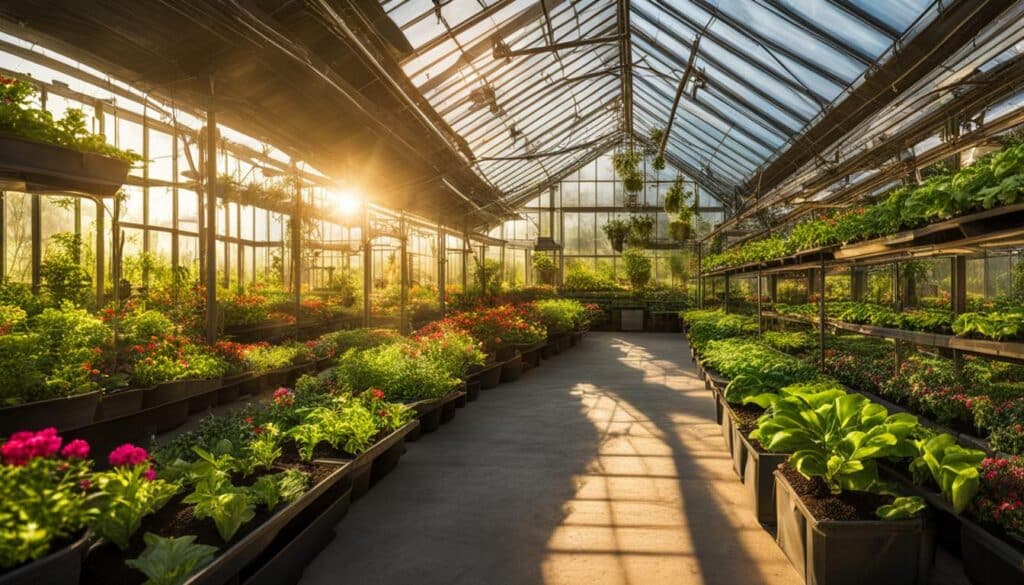
By using solar energy for greenhouse lighting, growers can reduce their reliance on traditional grid electricity, resulting in significant cost savings and a reduced carbon footprint.
“Solar-powered LED lights can not only provide the ideal light spectrum for photosynthesis but also offer the added benefits of energy efficiency and sustainability,” says Jane Smith, a greenhouse owner in California. “By harnessing solar energy for lighting in my greenhouse, I’ve been able to improve plant health while minimizing my environmental impact.”
The Benefits of Solar-Powered Greenhouse Lighting
When it comes to greenhouse lighting, solar energy offers several advantages:
- Cost savings: By using solar-powered lighting, growers can significantly reduce their electricity bills since solar energy is free and abundant. This can result in substantial cost savings, especially for large-scale greenhouse operations.
- Sustainability: Solar energy, as a renewable resource, provides a sustainable alternative to traditional energy sources. By harnessing the power of the sun, greenhouse owners can contribute to a greener and more environmentally friendly agricultural industry.
- Customizability: Solar-powered LED lights can be easily adjusted to provide different light spectrums based on the specific requirements of different plant species. This flexibility allows growers to optimize plant growth and maximize yields.
- Reliability: Solar energy is a dependable source of power, ensuring a consistent and uninterrupted lighting supply for greenhouse operations.
Innovations in Solar-Powered Greenhouse Lighting
Recent advancements in solar technology have further improved the efficiency and effectiveness of greenhouse lighting systems. For instance, some solar-powered LED lights are equipped with smart controls that adjust the light intensity and duration based on real-time data, optimizing energy usage and enhancing plant growth.
Additionally, integrating solar-powered lighting systems with automated timers and sensors allows growers to mimic natural sunlight cycles, ensuring the perfect conditions for photosynthesis and supporting the overall health of the plants.
By staying at the forefront of these innovations, greenhouse growers can harness the full potential of solar energy for lighting and take their operations to new heights.
| Advantages of Solar-Powered Greenhouse Lighting | Benefits |
|---|---|
| Cost savings | Significantly reduce electricity bills |
| Sustainability | Contribute to a greener and more environmentally friendly agricultural industry |
| Customizability | Optimize plant growth and maximize yields |
| Reliability | Consistent and uninterrupted lighting supply |
Utilizing Solar Energy for Heating and Ventilation in Greenhouses
Solar energy can be a game-changer in greenhouse operations when it comes to heating and ventilation. By harnessing the power of the sun, greenhouse owners can optimize temperature control and create an ideal environment for plant growth.
Installing solar collectors or thermal panels enables the capture of solar energy, which can then be converted into heat. This heat can be utilized to maintain optimal temperatures inside the greenhouse, especially during colder periods or at night when natural sunlight is limited. By relying on solar energy for greenhouse heating, growers can reduce their reliance on traditional heating methods powered by fossil fuels, ultimately leading to cost savings and a reduced carbon footprint.
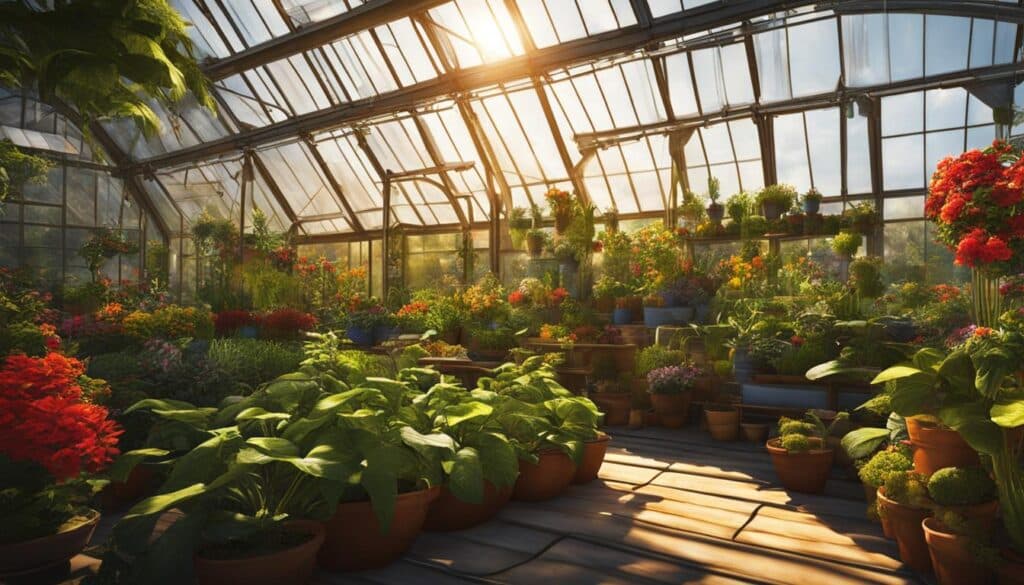
Additionally, solar-powered ventilation systems play a crucial role in regulating airflow and controlling humidity levels within the greenhouse. These ventilation systems, powered by photovoltaic panels, efficiently circulate fresh air and remove stagnant air, creating a healthier growing environment for plants. By integrating solar-powered ventilation, greenhouse owners can ensure proper air exchange, reducing the risk of diseases caused by excessive humidity and improving overall crop quality.
The use of solar energy in heating and ventilation not only provides energy independence but also contributes to a more sustainable approach to greenhouse operations. By reducing reliance on fossil fuels and grid electricity, growers can minimize their environmental impact and work towards a greener future. Moreover, solar-powered heating and ventilation systems require minimal maintenance and offer long-term reliability, ensuring consistent temperature control and optimal plant growth.
“Solar energy offers a sustainable solution for heating and ventilating greenhouses, empowering growers to create the ideal environment for their plants while minimizing the environmental impact.”
Advantages of Utilizing Solar Energy for Heating and Ventilation in Greenhouses:
- Reduced reliance on fossil fuels and grid electricity
- Cost savings in the long term
- Minimization of environmental impact and greenhouse gas emissions
- Improved temperature control and optimal plant growth
- Enhanced energy independence for greenhouse operations
- Sustainable and eco-friendly approach to agriculture
Advantages of Solar Energy in Greenhouse Operations
The use of solar energy in greenhouse operations offers several benefits. Firstly, it promotes sustainability by reducing greenhouse gas emissions and dependence on non-renewable energy sources. Solar-powered greenhouses have a lower environmental impact, contributing to a more sustainable future for agriculture.
Furthermore, solar energy provides significant cost savings in the long run. While there is an initial investment in installing solar panels and equipment, the ongoing operational costs are considerably lower compared to traditional grid electricity or fossil fuels. This translates to enhanced profitability for greenhouse growers.
Solar energy is a reliable and renewable source of power, ensuring a consistent and uninterrupted energy supply for greenhouse operations. By harnessing the power of the sun, growers can optimize plant health and create a greener approach to agriculture. Solar energy in greenhouses enhances productivity, reduces operating costs, and minimizes the environmental footprint. It is a win-win solution for both growers and the planet.
FAQ
What are some advanced solar energy techniques that can be used in greenhouses?
Greenhouse growers can utilize solar energy for lighting, heating, ventilation, and powering irrigation systems.
How can solar energy be used for lighting purposes in greenhouses?
Solar-powered LED lights can be installed to provide supplemental lighting, ensuring optimal plant growth even in limited natural sunlight conditions.
What are the benefits of using solar energy for greenhouse lighting?
By using solar energy for greenhouse lighting, growers can reduce reliance on traditional grid electricity, resulting in cost savings and a reduced carbon footprint.
How can solar energy be harnessed for heating and ventilation in greenhouses?
Solar collectors or thermal panels can be installed to capture the sun’s energy and convert it into heat, maintaining optimal temperatures. Solar-powered ventilation systems can regulate airflow and control humidity levels.
What advantages does solar energy offer in greenhouse operations?
Solar energy promotes sustainability by reducing greenhouse gas emissions and reliance on non-renewable energy sources. It also provides long-term cost savings, reliability, and a consistent energy supply for greenhouse operations.
Source Links
- https://commission.europa.eu/strategy-and-policy/priorities-2019-2024/story-von-der-leyen-commission_en?prefLang=el
- https://www.euractiv.com/section/energy-environment/news/vienna-agrees-to-fund-40km-pipeline-to-boost-gas-independence-from-russia/
- https://energy.economictimes.indiatimes.com/news/power/pm-modi-launches-projects-worth-rs-35700-cr-in-jharkhand/108138728

